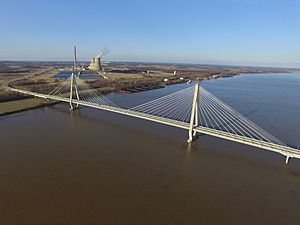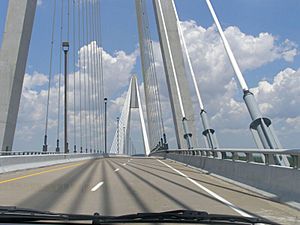William H. Natcher Bridge facts for kids
Quick facts for kids William H. Natcher Bridge |
|
|---|---|

View of William H. Natcher Bridge with the Rockport Generating Station in the distance.
|
|
| Coordinates | 37°54′04″N 87°02′02″W / 37.901172°N 87.033933°W |
| Carries | 4 lanes of |
| Crosses | Ohio River |
| Locale | Maceo, Kentucky to Rockport, Indiana |
| Maintained by | Kentucky Transportation Cabinet (KYTC) |
| Characteristics | |
| Total length | 4,505 feet (1,373 m) |
| Width | 67 feet (20 m) |
| Longest span | 1,200 feet (366 m) |
| History | |
| Opened | October 21, 2002 |
The William H. Natcher Bridge is a special kind of bridge called a cable-stayed bridge. It carries U.S. Highway 231 over the wide Ohio River. This bridge connects Owensboro, Kentucky to Rockport, Indiana. It first opened on October 21, 2002.
The bridge is named after William Huston Natcher. He was a U.S. Representative who worked for Kentucky from 1954 until he passed away in 1994. The bridge project was named in his honor just a few months before he died. The state of Kentucky owns this important bridge. The Kentucky Transportation Cabinet helped build it, working with the Indiana Department of Transportation and the Federal Highway Administration.
Contents
What Makes the Natcher Bridge Special?
The William H. Natcher Bridge is very long. It measures 4,505 feet (about 1,373 meters) if you include its ramps. The bridge is also 67 feet (about 20 meters) wide.
It gets its strength from strong cables. These cables are connected to two tall towers. Each tower is shaped like a diamond and stands 374 feet (114 meters) high. When it was built, it was the longest cable-supported bridge over a river inside the United States.
How the Natcher Bridge Was Built
Planning the Bridge
The idea for a new bridge near Owensboro started way back in 1987. A study suggested building a new bridge to connect to U.S. Highway 231 in Rockport. This was because the highway was very close to the river there.
Congressman Natcher began asking for money from the government for the new bridge in 1988.
Building Challenges and Delays
The actual building work happened in the late 1990s and early 2000s. It cost about $70 million. About $40 million came from the U.S. government, and $30 million came from the states.
The bridge was first planned to be finished by 1996. However, there were many delays in getting money from both the federal and state governments. The concrete piers, which are the strong bases for the towers, were put in place in 1995. But the main bridge construction did not start until 1998.
Even then, the builders hoped to finish by the end of 2000. But they realized this was too hard because installing the cables was very tricky. The bridge was finally officially opened on August 16, 2002. However, cars did not start driving on it until October 21, 2002.
The Natcher Bridge was designed by a company called Parsons, Brinckerhoff, Quade & Douglas, Inc. It was built by Traylor Brothers from Evansville.
Why Was the Natcher Bridge Needed?
This bridge was built for two main reasons:
- To help with traffic. The older Owensboro Bridge in downtown Owensboro was getting very crowded. The Natcher Bridge helped take some of that traffic away.
- To improve roads. It was part of a bigger plan to make U.S. Highway 231 a four-lane road. This new four-lane section connects Owensboro to Interstate 64 near Dale, Indiana. The full U.S. 231 connection to I-64 opened on March 15, 2011.
How the Bridge Changed Local Roads
After the bridge was finished, a new four-lane highway was built. This highway goes from U.S. Route 60 near Owensboro to the Natcher Bridge.
Because of this new road, U.S. Route 231 was changed. It now uses the new four-lane highway and goes around the city of Owensboro, Kentucky. The old part of U.S. Route 231 in Owensboro was renamed Kentucky Route 2155. In Indiana, the old U.S. Route 231 from the old Owensboro Bridge was renamed State Road 161.
In 2014, the Kentucky Transportation Cabinet also made another road improvement. They extended the US 60 By-Pass (also known as the Wendell H. Ford Expressway). This project, along with the Natcher Bridge and Indiana's work on U.S. 231, helps create a faster route. It makes it easier to travel from I-64 near Dale, Indiana to Interstate 65 in Bowling Green, Kentucky. This helps drivers avoid the busy city of Louisville, Kentucky.



